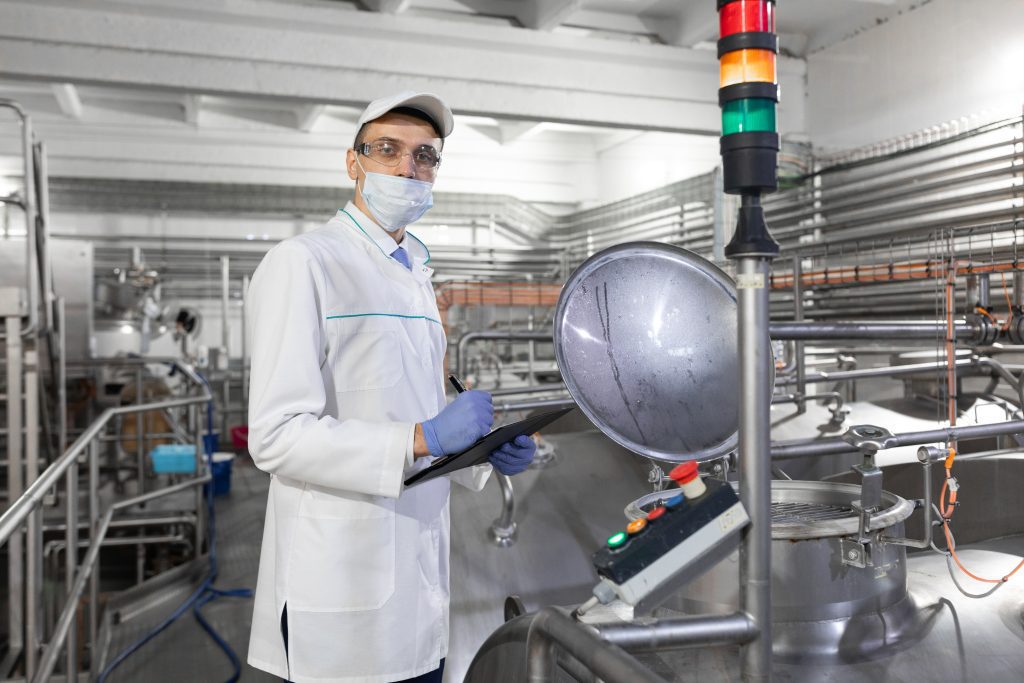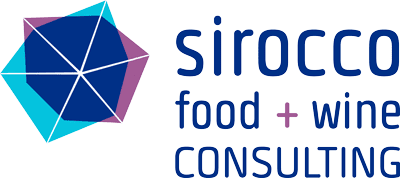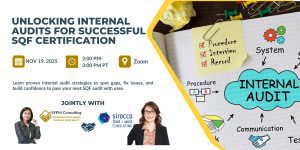As the food industry prepares for the official release of SQF Edition 10, there is a significant opportunity for manufacturers, processors, and importers to proactively strengthen their food safety programs. The proposed changes submitted for public comments in April are not simply procedural; they reflect a broader shift in expectations around organizational culture, change management, and compliance preparedness. Two essential areas that will define success under Edition 10 are the proposed implementation of a positive food safety culture plan for SQF and the proposed return of the SQF pre-audit process.
How SQF Edition 10 Raises the Standard for Food Safety Systems
SQF Edition 10 will represent one of the most significant updates to the Safe Quality Food Code in recent years. It is not simply a refinement of existing clauses, but a strategic shift designed to future-proof food safety systems and elevate accountability across the entire supply chain. From documentation to behavior-based metrics, Edition 10 introduces requirements that demand deeper integration of food safety into company culture, operations, and governance.
Key Structural and Procedural Enhancements
Documented and Measurable Food Safety Culture
Perhaps one of the most noteworthy additions found in the proposed changes submitted to public comments in April is the formal requirement for a positive food safety culture plan for SQF. The new standard requires businesses to develop and maintain a documented program with defined objectives, metrics, leadership engagement, and evidence of continuous improvement. Culture must be trackable, reviewed, and aligned with the organization’s broader food safety objectives. Companies will need to show that the plan exists and crucially, that it’s embedded and measured over time. Tools such as food safety culture maturity matrices on how to strengthen your SQF system can be found here.
Formal Change Management Protocol
Edition 10 introduces a dedicated clause on change management, requiring documented processes for evaluating and controlling risks associated with changes to equipment, materials, personnel, or processes. This addition reflects the increasing recognition that unplanned or poorly managed changes can compromise food safety. Businesses must now establish structured protocols to assess impacts, implement controls, and maintain traceability whenever operational adjustments are made.
Reintroduction of the SQF Pre-Audit Requirement for the Initial Site Certification
Under the proposed SQF certification updates, we may be going back to the pre-audit requirement of SQF 8.1. When implementing a food safety system, companies are required to “say what they do”, then “do what they say and prove it”. Under this certification process change, auditors would conduct a systematic review of policies, procedures and other controlled documents (“say what you do”) to ensure compliance with document control requirements in SQF 10, and this, ahead of the record review and site inspection (“do what you say and prove it”). The intent is to identify and resolve compliance gaps early, improving audit outcomes and fostering a mindset of continuous readiness. This proposed change also reinforces the importance of internal audits, a key requirement of the SQF code.
Centralization of Records and Documentation
To streamline audit preparation and improve transparency, Edition 10 consolidates documentation requirements into a unified section. This structural update is intended to reduce duplication, improve access, and help facilities manage records more efficiently. It also simplifies navigation for auditors, who will now encounter a more intuitive organization of policies, procedures, and evidence.
Increased Emphasis on Competency and Ongoing Evaluation
Training expectations have also evolved. Edition 10 calls for competency-based training across all roles rather than just basic instruction. Facilities must be able to demonstrate that employees understand and can apply what they’ve learned. This includes both initial onboarding and recurring education, along with evaluation tools that verify knowledge retention and practical application. This requirement ties directly into both the internal audit process and the broader positive food safety culture plan for SQF, where workforce engagement and accountability are essential.
Together, these changes represent more than a compliance update, they signal a philosophical shift toward proactive, evidence-based, and employee-driven food safety systems. Organizations that adopt Edition 10’s expectations early and with intention will not only position themselves for successful audits, but also build more resilient, high-performing operations.
Building a Culture That Supports Compliance

A positive food safety culture plan for SQF is no longer optional; it is a core requirement. Companies must demonstrate leadership commitment, employee engagement, and tangible metrics tied to continuous improvement.
An effective plan includes:
· Defined objectives that align with both SQF expectations and internal goals
· Leadership accountability for setting the tone and resourcing the program
· Employee awareness and participation through regular communication and feedback loops
· Culture-related metrics such as audit preparedness, issue response time, and training retention
· Continuous improvement through the review of performance metrics.
· Formal documentation of initiatives, outcomes, and reviews
This shift moves food safety culture from a conceptual idea to a measurable performance indicator that can impact audit outcomes.
Strengthening Compliance Through Internal Auditing
The proposed reintroduction of the SQF pre-audit reflects the industry’s increasing emphasis on proactive, self-managed compliance. This internal audit is conducted before third-party certification and serves as a powerful tool for identifying gaps, aligning documentation, and ensuring teams are prepared.
To make the most of the SQF pre-audit, facilities should:
· Use structured internal audit checklists aligned to Edition 10 standards
· Assign roles and responsibilities for audit execution and follow-up
· Track non-conformances and corrective actions over time
· Use audit findings to adjust training and improve procedures
· Link audit outcomes to broader food safety culture indicators
Facilities that integrate pre-audit findings into their culture plans are better positioned for long-term compliance and certification success.
Preparing Teams for Edition 10 Expectations

The human element of food safety has taken center stage in SQF Edition 10, with a renewed emphasis on how knowledge, behaviour, and accountability impact a facility’s overall compliance. It is no longer sufficient to show that training occurred: instead, organizations must now demonstrate the effectiveness of that training, link it to performance outcomes, and align it with a positive food safety culture plan for SQF. SQFI’s updates reflect global trends emphasizing employee empowerment, structured learning outcomes, and proactive leadership. As a result, preparing teams is about equipping every level of staff to contribute meaningfully to food safety systems.
Expanded Focus Areas for Workforce Readiness
Competency-Based Assessments
Training must go beyond attendance logs or signatures. Edition 10 places greater emphasis on verifying that team members understand and can apply the material. Competency assessments may include written tests, observed task performance, or ongoing evaluations tied to key performance indicators. This ensures that knowledge is retained and integrated into daily operations, particularly in critical areas such as sanitation, allergen control, traceability, and CCP monitoring.
Change Management Preparedness
Change management is newly codified in the proposed Edition 10 changes as a required component of operational systems. This demands that both staff and leadership understand how to manage updates to equipment, personnel, materials, and procedures. Training must cover how to initiate, evaluate, communicate, and document change in a way that maintains product safety and regulatory compliance. Ensuring that frontline employees understand the importance of change notifications and risk assessments is key to embedding these processes.
Cross-Functional Training and Role Clarity
Edition 10 wishes to reinforce the idea that food safety is everyone’s responsibility. Departments such as production, quality assurance, maintenance, and sanitation must understand how their roles intersect. Cross-functional training ensures that employees not only grasp their own procedures but are also aware of how they impact broader compliance. For example, maintenance teams should understand the food safety implications of equipment modifications, while QA staff should be looped into production changes early.
Internal Communication and Feedback Loops
The proposed changes to the SQF code Edition 10 place the emphasis on a positive food safety culture plan. Such change would require mechanisms for feedback and continuous learning. This may involve anonymous suggestion tools, structured debriefs after incidents, or regular team meetings focused on food safety topics. Critically, communication should be two-way; employees must have the opportunity to express concerns, ask questions, and contribute ideas. SQF Edition 10 supports the notion that engaged employees are more likely to follow procedures and identify risks early.
Leadership Visibility and Accountability
While not a training topic in the traditional sense, Edition 10 holds leadership accountable for creating an environment where training is valued and reinforced. Supervisors and managers must lead by example, participating in training sessions, recognizing good practices, and incorporating food safety performance into employee reviews. Leadership also plays a key role in allocating time and resources for meaningful training initiatives.
By embedding these proposed training expectations into daily routines and aligning them with the site’s positive food safety culture plan for SQF, businesses not only meet the new certification criteria; they also cultivate a workforce that is informed, confident, and capable of sustaining high standards under evolving regulatory frameworks. This integration between culture, training, and compliance is what sets high-performing facilities apart in the SQF ecosystem.
Leveraging Technology to Support Compliance Efforts
Digital solutions are becoming increasingly valuable for supporting SQF compliance. Whether managing a SQF pre-audit or documenting components of a positive food safety culture plan for SQF, technology can streamline the process and reduce the administrative burden.
Effective tools include:
· Document control systems for SOPs and audit logs
· Audit management platforms that track non-conformities and actions
· Dashboards that monitor food safety culture metrics and employee engagement
· Templates and workflows to guide training, communications, and reviews
Incorporating digital platforms not only improves efficiency but also provides traceability and evidence during certification audits.
The Business Case for Early Adoption

Although Edition 10 audits will not begin until 2026, organizations that begin implementing these practices now will be at a competitive advantage. Early adopters are more likely to pass audits with fewer non-conformities, secure retail contracts faster, and maintain a consistent reputation with certification bodies.
From a commercial perspective, investing in a robust SQF pre-audit process and a well-documented positive food safety culture plan for SQF is a strategic move. It demonstrates to all stakeholders-regulators, partners, and customers-that food safety is foundational to your operation, not an afterthought.
Next Steps for Food Businesses
To Prepare for SQF Edition 10:
1. Schedule and conduct a comprehensive SQF gap assessment against proposed changes.
2. Draft or revise your positive food safety culture plan for SQF with measurable KPIs.
3. Train staff on Edition 10 requirements and focus on improving your internal audit program.
4. Review your change management procedures and update documentation
5. Evaluate tools that can support compliance tracking and reporting
These steps will not only help meet regulatory expectations, but will also create internal alignment, reduce risk, and build long-term resilience in your operations.
Final Thought
SQF Edition 10 will mark a pivotal moment in the evolution of food safety certification. Compliance will no longer be achieved through documentation alone; it will also be supported by culture, leadership, and continuous improvement. By prioritizing your SQF internal audit process and executing a meaningful positive food safety culture plan for SQF, your business can lead the industry in both safety and operational excellence. SQF 10 certification updates will be finalized and published in August 2025.
For further information on how SQF Edition 10 may impact your business or to receive guidance on preparing for these updates, Sirocco Consulting is here to assist. Our team of experts can help you navigate the evolving certification requirements and ensure your operations remain at the forefront of food safety and quality standards. Contact us today to schedule a consultation or learn more about how we can support your certification goals.





